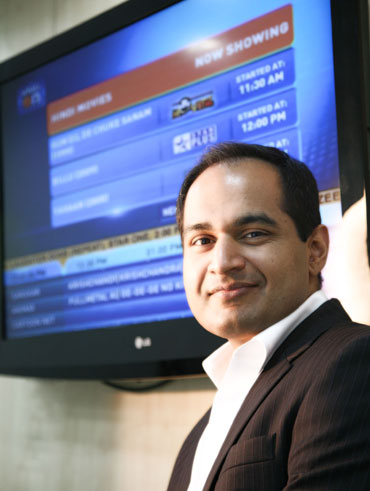
If you are reading this, chances are that you have, at some point in your life, sat in front of a television set on a Wednesday evening eagerly waiting for the weekly film song-based show, Chitrahaar, to start on Doordarshan and praying that there wouldn't be a power cut during the show.
Or at least you would have heard first person accounts from people who have done this in the 1980s and early 1990s.
Cut to 2010. There are over 400 TV channels in India with thousands of shows and films everyday, and it is still difficult to find something worth watching. In other words, the problem of plenty has become the bane of Indian TV watchers today.
Enter Atul Phadnis with his company What's On India and the slogan -- 'What to watch when you don't know what to watch'.
Modelled on TV guidance channels worldwide, What's On India launched India's first consumer TV guidance channel in December 2009.
Click NEXT to find out how it works . . .
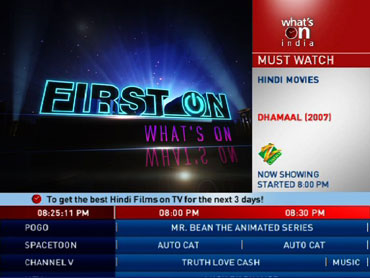
The proposition is that viewers can check what's showing on TV at any time and get recommendations on the best shows, films, sports, documentaries and events to watch.
"Studies conducted by What's On India in 2009 revealed a host of insights about changing viewership patterns owing to an increase in the number of channels in India. We discovered that 70 per cent of TV sessions in India are unplanned, meaning viewers turn on their TV sets not knowing what to watch. And these viewers spend a frustrating 3 to 10 minutes of their TV session just searching for shows that match their taste and mood. This is where we come in," says Phadnis, the company's CEO.
Phadnis, who has over 15 years of experience in media and advertising, found that Indian TV viewers need help. He realized this as early as in 2004, when talks of implementing a digital mode of transmission for TV channels through a set-top box had started doing the rounds.
This system, also known as Conditional Access System or CAS, initiated various debates about its viability across the country. At this time, Phadnis, however, was thinking of the confusion that the TV audiences would go through once hundreds of TV channels become available to them because of analogue TV homes turning digital.
He saw here an opportunity to create a company that would help the viewers decide what to watch. And by the end of 2005, What's On India was born.
Click NEXT to see what if offers . . .
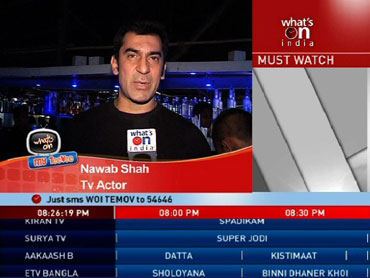
What's On India started by developing an Electronic Program Guide (EPG) for TV. This is the same guide that the users of DTH or digital cable get on their TV through which they can surf and find the channels or programmes of their choice.
It took the company two years to build this system . Having accomplished this, Phadnis wanted to launch a TV guidance channel that could further simplify the decision-making process by offering previews and recommendations.
The channel was launched in December 2009 and has already reached 20 million homes across the country. By the end of the current fiscal year, the company aims to double this reach to 40 million homes.
The channel has three parts to it. The bottom one-third of the screen plays a constant scroll showing a programme guide aimed mainly at viewers who are still on the analogue system or the regular cable, and therefore are not able to get the EPG that comes with set-top boxes.
The rest of the screen is divided into two parts: on the right is what Phadnis likes to call 'the breaking news' or the best shows coming up next across channels. Viewers can also set SMS reminders of the shows they like.
Click NEXT to figure out how it makes money . . .
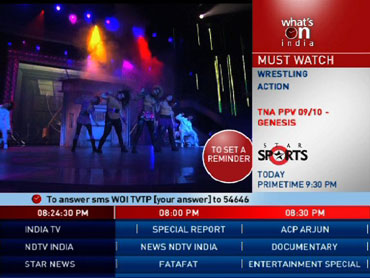
The biggest and the central part of the screen is the 'entertainment' area playing the What's On Specials. This is where the channel makes its money. This part carries promos and sneak previews from various current and upcoming shows and the TV channels have to pay for their promos to run here.
Catch-up-TV, showing recaps of popular shows is another offering on the What's On India channel.
Other than this, the company also produces some shows like the one where celebrities recommend their favourite TV programmes, and a behind-the-scenes show which is shot on the sets of popular TV serials.
Phadnis plans to monetize this original programming by selling advertising space on these shows like any other TV channel. "Our business model is simple -- licensing revenues for our EPGs from the operators, and advertising revenues for the channel from TV channels and traditional advertisers," he says.
What's On India also has a website and some plans for mobile. But Phadnis says that these plans are exploratory and the company is still trying to arrive at the best solutions in these areas.
Click NEXT to read on . . .
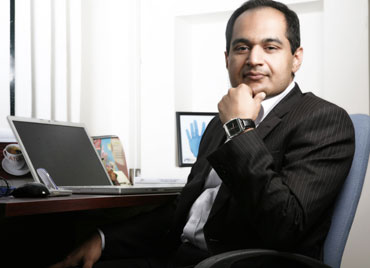
As for printing a TV programme guide, Phadnis says that in India, that's not an option. "We are a last-minute country. Every morning we get some 200 changes from broadcasters. This makes it very difficult to plan in advance and print a weekly or monthly TV guide."
For the future, features like region-wise geo-targetting for show recommendations and other customization tools to suit different people's tastes are on the company's agenda.
Internationally there are multiple TV guidance channels in one country with the TV networks themselves sometimes operating their own guidance channels. The service providers also have their home channels also known as Barker channels which are used to promote various shows.
However, Phadnis feels that in India since What's On India is the first and only TV guidance channel at the moment, his first-mover advantage will take him a long way and he hopes that his channel will become the default first channel that viewers go to after switching on their TV sets.